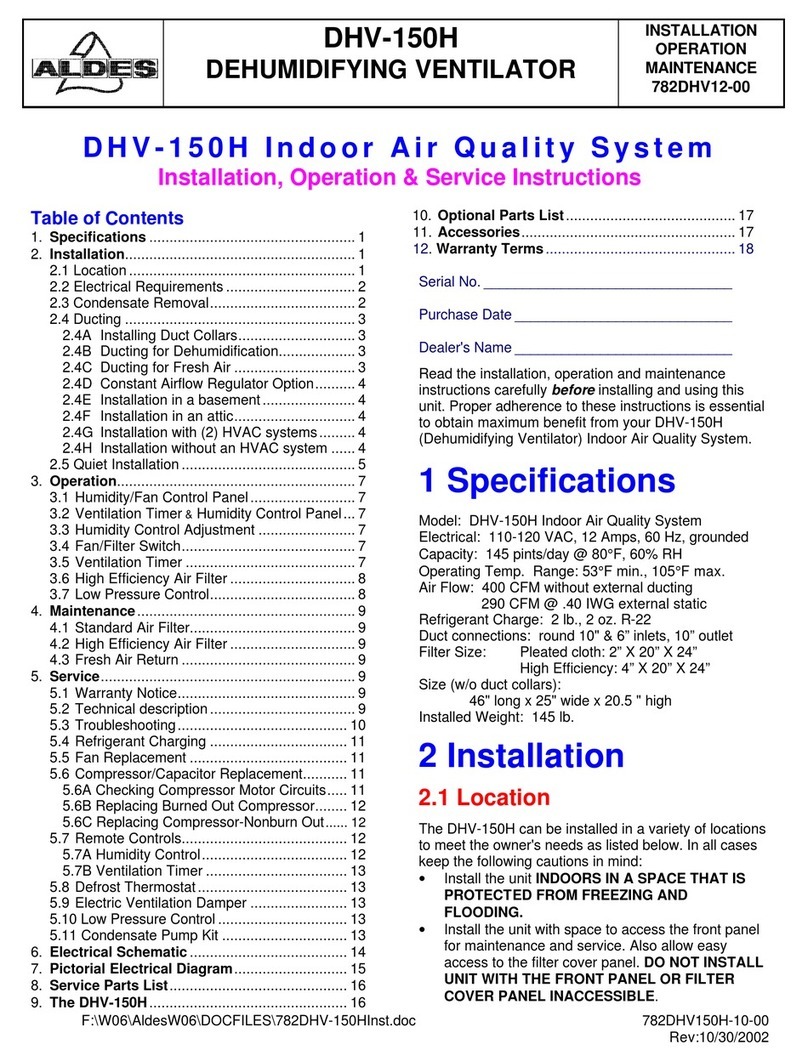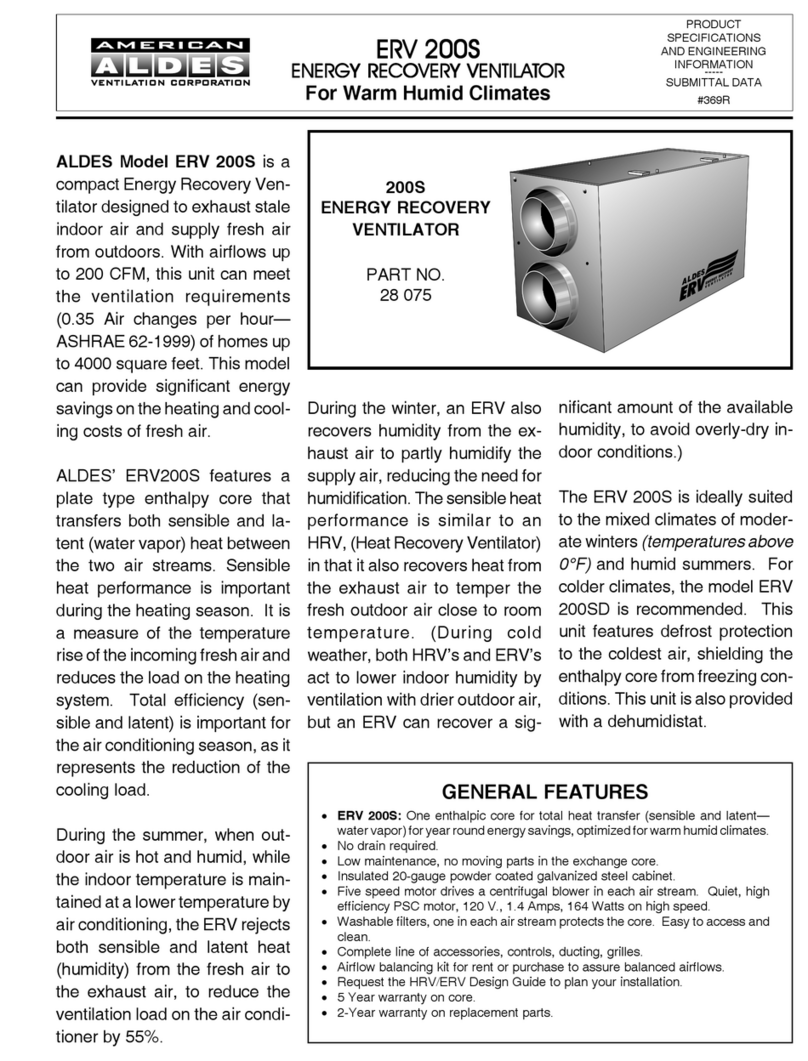
CHOOSINGTHERIGHTREMOTEMOUNTBLOWER
Below is a chart of the recommendedALDES fans that can be used with the HLS & HLD Series
range hood liners. Some models are for mounting remotely in the attic. Other models are used
when installation requires a roof mount or wall mount fan.
Model Location Mounting Airflow @ 0" Typical Airflow†
A-6 interior inline 257 190
A6HP interior inline 392 275
XMV-A6HP exterior wall 381 330
RMV-A6 exterior roof 227 205
HLS 30 & HLS 36
Model Location Mounting Airflow @ 0" Typical Airflow†
A8-HP interior inline 521 450
AD-8HP interior inline 836 650
XMV-A8HP exterior wall 435 370
RMV-A8HP exterior roof/wall 401 350
HLD 36
Model Location Mounting Airflow @ 0" Typical Airflow†
A-10HP interior inline 590 525
AD-10HP interior inline 1266 1020
RMV-A10HP exterior roof/wall 753 721
RMV-A10HPT exterior roof/wall 1008 919
HLD 42 & HLD 48
†Typical airflow is an estimate based on a system with 20-feet of duct, two 90 degree elbows,
backdraft damper, roof cap and filter.
*Representative of full-speed operation @.375 s.p. in a typical installation.
NOTE: Due to the large volume of air that these remote blowers move, it is important that a
source of sufficient makeup air is available to avoid backdrafting in the house.
PART 2 Electrical Connection
WARNINGS:
1. Ensure that the power supply is disconnected before proceeding.
2.Verifythatthepower supply matches theratingsfoundontheappliancedatalabel before
proceeding.
3. The complete appliance must be properly grounded at all times when electrical power is
applied.
4. Do not ground the appliance with the neutral (white) house supply wire. A separate
ground wire must be utilized.
5. Failure to complete electrical connections properly may result in damaged or nonfunc-
tional systems. Follow instructions carefully to ensure proper installation.
• It is the owner’s responsibility to ensure that a qualified electrician performs the electrical
connection of this appliance. The electrical installation, including minimum supply wire
size, must comply with the National Electric CodeANSI/NFPA 70-1990 (or latest revision)
and local codes and ordinances.
• A copy of this standard may be obtained from National Fire Protection Association, 1
Batterymarch Park Quincy, Massachusetts 02269-9101
INSTRUCTIONS:
1. A 15 to 20 amp electrical service is recommended for proper electrical supply. Before
determining, calculate amp ratings based on the product label found on the liner and the
ventilator. (Always observe local building codes).
2.Always use a dedicated circuit.
3. Line load is calculated by adding the amperage of the halogen lights to the rated amper-
ageofthe ventilator (eitherin-lineorrooftop). Ifthe ventilator isratedinwattsrather than
amps, divide the watts by 120 and this will give you the amperage rating.
4. TheALDES liner is supplied with a 5.0 amp variable speed fan control. Make sure the
rated amperage on the ventilator does not exceed 5.0 amps.
5. The ALDES liner has been designed to accommodate several different motor speed
controls, (for example ThermadorTM model CTR3-Q). Always consult the manufacturer’s
installation instructions when substituting control switches.
6. Wire connections: (Figure 2)
•Black — 120 VAC from electrical panel (black)
•White — Neutral from electrical panel (white)
• Green — Ground from electrical panel (green)
• Red — 120 VAC variable control to 120 VAC of ventilator
Figure2
CAUTION: The neutral wire (usually white) for the ventilator must connect to the same neutral
wire that comes from the electrical panel to the liner. It is recommended to run a white
neutral wire from the liner’s white neutral wire along the same path as the red wire from
the liner’s variable speed control to the ventilator.
1259
PART 3 Securing the Liner
SECURINGINSTRUCTIONS:
1. Because the professional series liner was designed for custom applications, no mount-
ing holes have been predrilled. This allows you to attach the liner in the areas of the
canopy which have ample support and backing.
2. Youmustsecure the linerthroughbothrightandleft sides, throughthebackandthrough
the top.
3. Remove the filters. Mark and drill screw holes through the liner as required for custom
canopy. Secure the liner by driving screws (provided by others) through the stainless
steel into the framing and backing.
CONNECTINGTO THEVENT PIPE:
1. Insertthetabbedendofthegalvanized Start Collarintotheroundholeintheoutsidetop
of the liner.
2. Bendallofthetabsfirmlyinplacesagainsttheinsidetopoftheliner. Sheetmetalscrews
should be placed equidistant through 3 or more tabs. CAUTION: For safety of the
person cleaning this liner, neatly cover the well-flattened tabs with 2 or more layers of
metal tape.
3. Attach the other end of the Start Collar to the range hood vent with a minimum of 3
equidistant screws and metal tape.
PART 4 Use & Care
OPERATINGCONTROLS:
1. Alwaysactivate the ventilatorwhenever using cooking appliances.
2. Activatetheventilatorafewminutesbeforestartingtocooktoestablishanairflowpatternwithin
the room.
3. Adjustthe fan speed accordingto the amount ofcooking exhaust.
4. Adjust the dimmable halogen lights as desired.
5. Eliminate air currents in the hood vicinity by shutting nearby windows and doors, turning off
ceilingfans and closingthe adjacent heatingand air conditioningoutlets.
6. Placeyourlargestpans,skilletsand stock pots on the rear burners whenever possible.
WARNING: DO NOT operate the vent system without the filters in place, or with dirty, grease
laden filters.
ENERGYSAVINGTIPS:
1. Do not operate the blower at a speed that is higher than necessary to remove the cook-
ing exhaust. Running at excessive speeds removes more air from the inside of the
house that must be replaced by outside air. This may be especially costly when your
home’s heating or air conditioning system is in operation. Turn off the unit once the
smoke and cooking odors have been eliminated.
2. Clean filters and grease laden surfaces often to improve efficiency.
3. Always use lids on cookware to retain heat and moisture.
4. Minimize the amount of liquid used to cook food.
5. Select cookware of proper size, material and construction for the cooking task being
performed.
CARE&CLEANING:
1. Proper cleaning is necessary to maintain performance and appearance, while also en-
suring safe operation. The frequency of cleaning should be adjusted according to the
type and amount of cooking. Best results will be achieved by cleaning soiled compo-
nents as soon as possible.
2. Filters must be cleaned regularly. Remove one filter at a time. On models HLD-36, 42,
& 48, grasp the filter handle and gently pull toward you, then down and back. Filter
shouldbeinstalledwiththehandlein the rear filter slot. On model HLS-30, insert a blunt
knifeinto the small slot inthe front edgeof the filter. Push down andback. Filter should
be installed with small slot at the front of the filter.
3. The filters may be cleaned by hand washing in hot water using a mild detergent solution,
orby placing them inthe top rack ofanautomatic dishwasher. Drythefilters completely
before using again.
4. Stainless steel surfaces should be cleaned with a solution of mild detergent and warm
water. Rinse and dry with a soft lint-free cloth. CAUTION: Do not use any type of pad
that will scratch the liner.
5. CAUTION: If a commercially available stainless steel cleaner is used, it is important to
read the labels for chlorine compounds. Chlorine is a corrosive substance. If these
compoundsare present,rinsethoroughlyanddry withasoftlint-free cloth. Followpolish
manufacturer’s instructions.
6. Always wipe stainless steel surfaces with the grain. Never wipe across the grain.
7. After cleaning, reinstall the filters carefully.
REPLACINGLIGHTBULBS:
Par20halogenlampsareavailableinmanydifferentstylesandsizes. Followingisalistrecomended
by the manufacturer:
• Phillips MASTER Line 50 watts 120V • Felt Electric 50 watt 130V
• Industrial Grade Premium QualityTM P.Q.L. Incorporated Code 83009
4537 NORTHGATE COURT
SARASOTA, FL 34234-2124, USA
Tel: 941-351-3441 Fax: 941-351-3442
www.americanaldes.com























